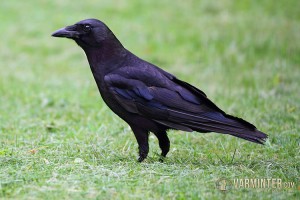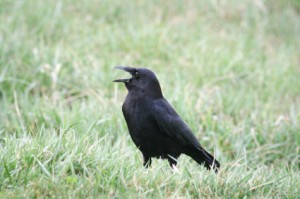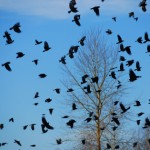Family, Description and Size:
The Crow is a member of the Corvidae family of Birds. The typical American Crow is a bird that has distinctive iridescent black feathers all over its body and its legs and bill are also pitch-black. Their bills are rather long, spanning between 1 and 2 inches and varying from area to area subspecies. Crows measure 16-21 inches in length, of which 40% is their tail alone.
The American Crow’s wingspan ranges from 33 to 39 inches and their body mass vary from 11.1 oz to 22 oz.
Range and Habits:
The American Crow can be found all over North America. They also can be found from the Pacific to the Atlantic coast throughout Canada, in Northern Mexico and the French islands of Miquelon and Saint-Pierre. It lives in
almost all kinds of habitats, from forest, prairies and deserts to cities and suburbs. The only habitats that aren’t actually home to crows are Pacific temperate Rain Forests and the Tundra, where one can find Ravens instead.
The American Crow is an omnivore that eats a huge variety of foods, including human garbage, seeds, nuts, fruit, invertebrates, stranded fish, carrion, eggs and nestlings. They are good hunters and will actively hunt for mice and frogs. However, it depends largely on nuts and acorns for its survival.
Where they are available Crows will eat the crops of farmers, especially wheat and corn. However, crows also eat most pests that feed on crops. So, in many occasions the crop damage done by crows might be less than is often considered as it is partially offset from their removal of pests. It is dangerous to completely wipe out crows from farmlands, as pest populations will increase and different problems may arise.
General Information:
Crows are monogamous, cooperative breeding birds. This mean a male and a female will breed for life and raise their nestlings. The young of the previous season will often stay with their parents and help raise the new nestlings. They lay about 3 to 8 eggs by April and within 35 days those will hatch.
Families of crows rearing nestlings together may be up to 18 heads strong. They are highly social and cooperative, with a clearly defined hierarchy. Crows sometimes amass in huge communal roosts, occasionally numbering in the hundreds of thousands.
Crows are well known for their intelligence that often surprises humans. Crows have been seen to use tools (usually a much loved thin stick) to catch grubs from trees and crows have been recorded throwing hard nuts onto the street when traffic lights go green so that cars would smash the nut open. The crow then proceeds to eat the soft interior when the traffic lights turn red.
Predators, Mortality and Lifespan:
Humans are the main predator of the American crow, since they are considered a pest by farmers. They also easily succumb to the West Nile virus and die of famine. When they are still nestlings, predators like Domestic Cats, Snakes, Raccoons and Ravens may kill them. Adults are rarely predated upon by Bobcats and Coyotes, as well as Great Horned Owls, Peregrine Falcons, Eagles and red-tail Hawks. Because Crows are a migratory bird, some states regulate their take with specific seasons and should only be hunted if the season is open or if depredation hunting permission is obtained.




